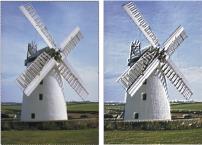Quick links to procedures on this page:
Corel Painter lets you produce surface texture based on an alpha channel or a layer mask. You can use this method only if you added an alpha channel, or a layer that contains a layer mask, to the image.
When you apply the texture to a channel, the area that surrounds the edges of the channel appears raised. When you apply texture to a layer mask, the layer mask acts as a boundary for the texture and the texture appears around the edges. For more information, see Creating and deleting layer masks.

Before (left) and after (right) adding texture based on a saved alpha channel.

Before (left) and after (right) adding texture based on a layer mask.
|
1
|
In the Layers panel, select a layer or the canvas. |
|
2
|
Choose Effects  Surface Control Surface Control  Apply Surface Texture. Apply Surface Texture. |
|
4
|
Adjust the Softness slider to control the amount of distortion created by the texture. |
|
5
|
In the Appearance of Depth area, adjust any of the following sliders: |
|
• |
Amount — controls how much surface texture is applied to the image. Moving the slider all the way to the right applies the maximum amount. |
|
• |
Picture — controls how much of the color from the original image is applied to the texture. At 100%, the full color of the picture shines through. Moving the slider to the left displays more black, leaving only the shine. |
|
• |
Shine — controls how much highlight appears on the surface of the texture. Higher Shine values make the texture look metallic. |
|
• |
Reflection — maps a clone source image or pattern onto the texture at a variable percentage |
|
6
|
In the Light Controls area, adjust any of the following sliders: |
|
• |
Exposure — adjusts the overall lighting amount from darkest to brightest |
Copyright 2013 Corel Corporation. All rights reserved.
